|
Panasonic Toughpad
Panasonic's tough Android tablet makes grand entrance at Dallas Cowboy Stadium
(by Conrad H. Blickenstorfer and Carol Cotton)
On Monday, November 7, 2011, Panasonic unveiled the Toughpad family of what the company describes as "professional-grade Android-powered tablets." And Panasonic did it in grand style by introducing the new tablets at the Dallas Cowboy Stadium in Arlington, Texas.
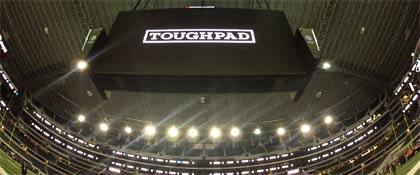
The line will include a 10-inch device with a form factor similar to that of the Apple iPad, and a considerably smaller 7-inch device with a wide-format display. Here's what the larger 10-inch tablet looks like:
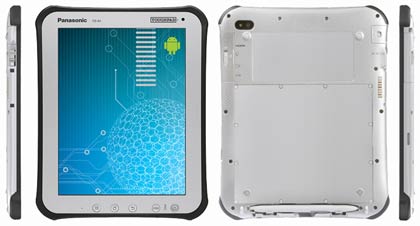
In essence, Panasonic has decided to complement its already considerable lineup of rugged, business-oriented notebooks, handhelds and tablets with an Android tablet that employs the general size, design, technology and form factor of the successful Apple iPad, but in a more enterprise-oriented version with enterprise-class security and the ruggedness the company's products are famous for.
The Panasonic Toughpad A1
Here's what you get with the 10-inch version of the upcoming Panasonic Toughpad: a tablet with a 10.5 x 8.4 inch footprint (versus 9.5 x 7.5 for an iPad) that weighs just over 2 pounds and is about 0.7 inches thick. That's a bit bigger, thicker and heavier than the iPad, 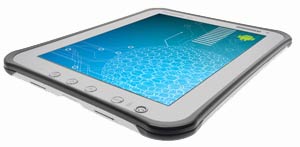 but the overall look and feel is still much more that of Apple's megahit than that of an older-style Tablet PC. That's probably a good thing as by now, almost two years into the iPad's reign, it sort of looks like people don't want a tablet, they want an iPad. So Panasonic is now making a tablet that invokes the iPad's size and appeal, but elevates the concept into business class. but the overall look and feel is still much more that of Apple's megahit than that of an older-style Tablet PC. That's probably a good thing as by now, almost two years into the iPad's reign, it sort of looks like people don't want a tablet, they want an iPad. So Panasonic is now making a tablet that invokes the iPad's size and appeal, but elevates the concept into business class.
It's a tablet with the 4:3 display aspect ratio screen Apple decided to use in the iPad, and the same 1024 x 768 pixel resolution that, incidentally, the Toughbook 19 and 31 also use, making application portability that much easier. It's a tablet that uses capacitive multi-touch technology to let users tap, pan, pinch, rotate and zoom with iPad ease and speed, but it also has a pen for when you need precision, draw, doodle, or capture signatures. It's also a tablet with the kind of anti-reflective and anti-glare treatment as well as superior backlight power that keeps the display viewable and usable outdoors and in the sun.
There are two cameras, 2-megapixel in the front for conferencing, and 5-megapixel in the rear for documentation, and the one in the rear has an autofocus mechanism and LED illuminator. There are micro-USB and micro-HDMI ports you can use without adapters, and LAN is available via the cradle. For wireless there's dual band 802.11a/gb/g/n WiFi, Bluetooth 2.1, and optional mobile broadband, including 4G LTE or WiMax. There's even a Wi-Fi hotspot router that can support up to five devices. The Li-Ion battery packs 34 watt-hours, good for "approximately ten hours" and it is field-replaceable.
On the memory and storage front, the Toughpad A1 has 1GB of RAM, 16GB of Flash, and also a microSDHC slot that can accommodate cards of up to 32GB capacity.
What's taking so long?
The only question here seems to be: what took Panasonic so long, especially considering that even now, the Toughpad won't ship until the Spring of 2012.
It's hard to say what works and what doesn't in the tablet space. Pen tablets failed to catch on in the past, but then Apple succeeded big with the iPad. Yet, even as iPads sell by the tens of millions, no one else has been able to come close to the iPad's success. While Android is very successful in smartphones, Android-based tablets have not (yet) caught on. And to make matters worse, Microsoft's announcement of a touch-oriented next version of Windows did its part in spreading fear, uncertainty and doubt amongst potential iPad competitors.
Panasonic's approach
Panasonic, like its competitors, undoubtedly sees a big opportunity in tablets, but also knows that it has to be done right, and at this point it's not totally clear what "right" means, as Motorola Mobility and others have found out the hard way. From the looks of it, Panasonic is betting on a combination of familiar form factor, addressing iPad weaknesses (outdoor viewability, ruggedness, security), and its own successful Toughbook DNA.
Ruggedness
The iPad is certainly durable and well made, but it's definitely not rugged. The Toughpad, on the other hand, is. The display has a protective film. The device is sealed to IP65 levels (i.e., totally sealed against dust, and protected against low pressure water jets from all directions). It can handle operating temperatures between 14 and 122 degrees Fahrenheit, it can handle 4-foot drops, it's been vibration tested for use even in helicopters, it can handle 15,000 feet altitude and it passes numerous standards and requirements. And, like all hardened Panasonic computers, it's tested both inhouse and by third parties.
Below, shown on the giant HD Dallas Cowboy Stadium video display board (the 2nd largest in the world), a Panasonic Toughpad is being soaked on the job.
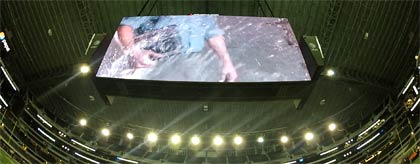
Performance AND security
Tablets must be quick and operate as effortlessly as the iPad in order to succeed. But enterprise and IT require an extra level of security that is hard to achieve with software alone. And this may be one reason why Panasonic held off until all the right hardware became available.
See, as far as the Toughpad processor goes, the spec sheet simply says that it is a Marvell 1.2GHz dual-core design. That's interesting as the majority of currently available Android tablets use nVidia Tegra processors. Marvell, of course, is the company that bought the XScale processor line that's been powering most Windows CE handhelds from Intel a few years ago. Though not widely known in the smartphone and tablet business for now, Marvell's ARMADA family increasingly covers the entire spectrum of application processors, and apparently its appeal is strong enough for Panasonic to have chosen Marvell over nVidia, TI, Qualcomm or others.
From what we can tell, the only 1.2GHz dual core chip in Marvell's lineup is the new PXA 2128, an ARM v7 chip, and a remarkable design indeed. What makes it special and especially suitable for the Toughpad?
First, the PXA 2128 is a hybrid chip that combines a 1.2GHz dual core, dual channel processor with an ultra-low power core. So just like a Toyota Prius uses its electric engine to roll around the parking lot or neighborhood and then its gas engine on the highway, the PXA 2128 uses its ultra-low power core for browsing and regular work, and then its powerful symmetrical multiprocessing cores for demanding work.
Second, the PXA 2128 has an integrated quad shade GPU that can handle dual stream 1080p HD video encoding and decoding. That means that the Toughpad's 2mp front camera may be able to record (and then transmit via 4G wireless) 1080p video which, after all is 1920 x 1080 pixel.
Third, the PXA 2128 includes what Marvell calls a "commercial class security engine." That certainly plays a role in Panasonic's claim of the Toughpad having enterprise level security that goes beyond what iOS and standard Android 3.x can provide.
Specifically, when compared to standard Android, the Toughpad offers enhanced enterprise VPN, hardware encryption, trusted boot, embedded security processor functionality, as well as FIPS 140-X security (FIPS 140 is a U.S. government computer security standard that specifies cryptographic requirements) and HIPAA compliance (HIPAA is the Health Insurance Portability and Accountability Act and includes security standards to protect the use/disclosure of personal health information). For an intro to the Marvell PXA 2128 chip, see this video.
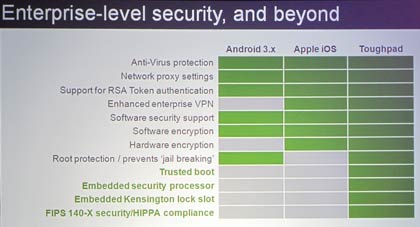
Launch at the Dallas Cowboy Stadium
The official announcement of the Panasonic Toughpad happened quite spectacularly on November 7, 2011 at the stunning new Dallas Cowboy Stadium in Arlington, Texas. No, the event of course did not fill the stadium, nor was it held during a game. What Panasonic did was introduce the device to an assembly of maybe 500 customers, analysts, the media, and other interested and invited parties. Below are some pictures from the impressive multimedia presentations.
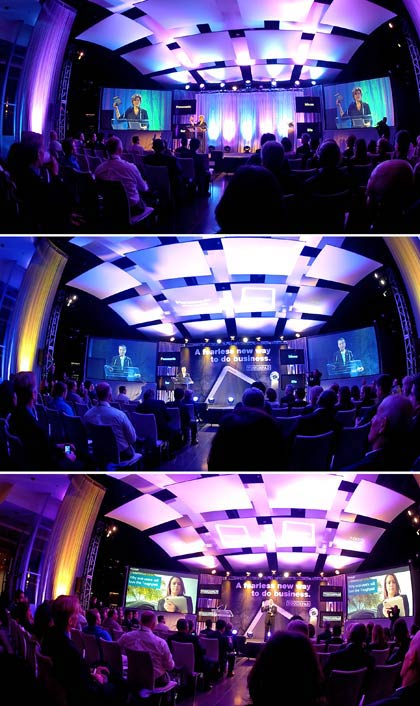
Panasonic executives talked about Panasonic's leadership in the rugged market, the low failure rates of its products, and then made the case for adding the Toughpad to their lineup. The tablet market is one of the fastest growing ever, and the use of tablets is rapidly spreading into the enterpise. iPad competitors so far have struggled to gain traction, while iPad activations have soared, especially in the financial services industry.
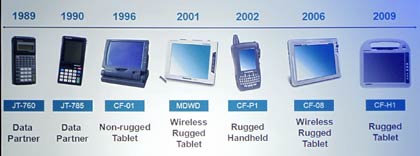
Panasonic, building on its considerable experience in the tablet space, used market projections, industry analysis, and customer requests to come up with "the first tablet designed for business," one that is simple, easy to to use, highly reliable, with superior service, support and, most of all, security.
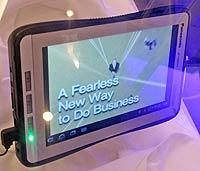 Panasonic also announced that there would be a smaller Toughpad B1 with a 7-inch display, to be released later in 2012. A couple of B1 tablets were displayed behind glass. They are significantly smaller than the A1 and their 7-inch display uses a wide format, giving the device a very different look though the overall design is the same as the larger tablet. Panasonic also announced that there would be a smaller Toughpad B1 with a 7-inch display, to be released later in 2012. A couple of B1 tablets were displayed behind glass. They are significantly smaller than the A1 and their 7-inch display uses a wide format, giving the device a very different look though the overall design is the same as the larger tablet.
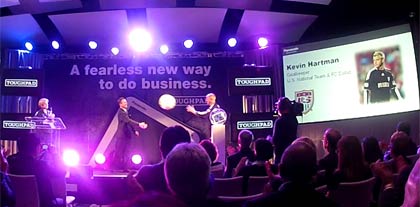
Panasonic then introduced Kevin Hartman, goalkeeper of the FC Dallas and the U.S. National Team and Abby Wambach, forward of the U.S. National women's soccer team, and with that, the assembly resorted down onto the field where the Dallas Cowboys play, a totally unique and memorable opportunity to experience a sports landmark from a vantage point few ever get to enjoy.
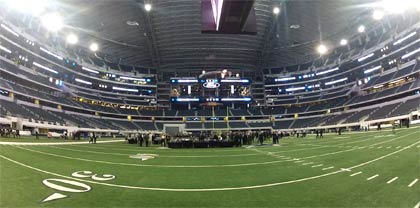
On the field, those brave enough to put on cleats got an opportunity, under the tutelage of Wambach, to test the national goalkeeper. How many people can claim to have scored a goal against Kevin Hartman?
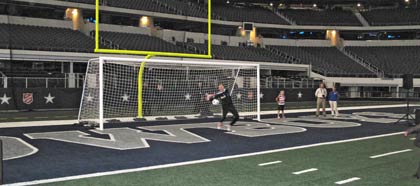
Partners and the Business AppPortal
One area where Android tablets have been facing an uphill battle is apps. Panasonic points out that besides having access to the existing and rapidly growing selection of Android Market applications, the Toughpad will be supported by the Business AppPortal, an enterprise-focused app store offering best-of-breed vertical market specific solutions as well as applications addressing broad enterprise concerns, including Mobile Device Management, security and virtualization.
The Business AppPortal is a highly secure, cloud-based user storefront that allows IT Managers and developers to store, download and test applications for use on Toughpad devices. Panasonic will also offer private application stores within the Business AppPortal that businesses can customize to meet their specific needs.
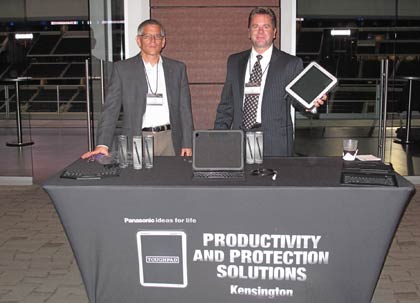
At the launch event in Dallas, over two dozen partners demonstrated their hardware and software solutions. It was interesting to see a good number of production quality solution months before the device starts shipping. It also gave the assembly an opportunity to get hands-on with the Toughpad.
Where does the Toughpad go from here?
When Apple announces a product, it's usually available for sale the same day or within a week or two. The Panasonic Toughpad isn't. Which surprises a bit since even the grand Dallas Cowboy Stadium announcement came over four months after Panasonic's initial announcement (sans specs) of an Android tablet. 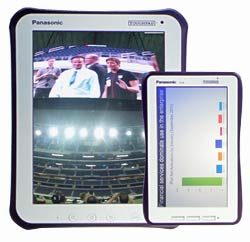
As is, perhaps waiting is just as well. With the exception of the iPad, tablet computers have always been a tough sell. Reputations are hard earned, and easily lost. It's also true that being the first to market is not always a good thing.
Then there's Microsoft which will undoubtedly make a big push to get renegade Android tablet experimenters back into the fold. And in the tablet market where Android hasn't so far achieved the commanding position Android has in smartphones, their argument could be strong as it'd hardly make sense to support two tablet operating systems.
As a product, the Panasonic Toughpad is compelling enough. It is attractive, properly sized and configured, secure, rugged enough to prevail where iPads can't, and by all accounts it seems well equipped to succeed where prior tablets did not.
Panasonic
panasonic.com/toughpad
Ph: (800) 662-3537
|



